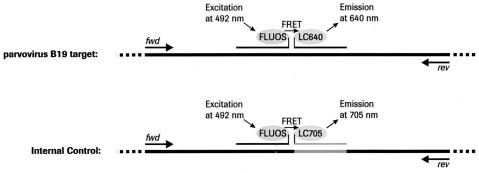Figure 1.
Principle of simultaneous target and IC amplification and detection using hybridization probe technology. The target DNA as well as the IC DNA is co-amplified by means of PCR using the identical set of primers. During the annealing phase, the hybridization probes labeled with FLUOS at the 3′ end and with LC640 at the 5′ end, respectively, specifically bind to the single-stranded target sequence in direct proximity, thus allowing a fluorescence resonance energy transfer (FRET) resulting in a signal detectable at 640 nm. The IC is a plasmid that provides the original target amplicon with the exception for an exchange of the second hybridization probe binding site for a sequence complementary to the IC-specific hybridization probe being labeled with LC705 at the 5′ end. The signal generated in the presence of the IC is detectable at 705 nm and can thus be distinguished from the target signal in the LightCycler instrument. Since amplification of the target and IC sequence competes for the same pool of primer, the IC has to be positive with parvovirus B19 DNA-negative samples but may be negative with with parvovirus B19 DNA-positive samples.

